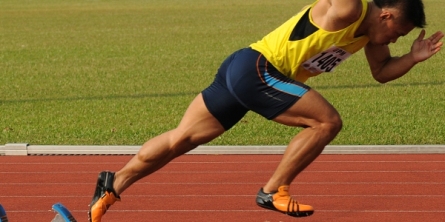Ah running… the most widely practiced physical activity in the world with nearly two billion people jiggling their way to a body only a mother could love. From those staggering numbers it’s confirmed that we, as an industry, are not even close to where we need to be in terms of strength training frequency.
Let’s be honest, in 2015, it’s pretty damn hard to make CrossFit look like the less shitty alternative to an unsafe and ineffective form of training. Running wins this battle due to the punishment it delivers to your body with each successive step. Each leg pounds into the ground with the force of 4 times your body weight!
I don’t know about your country, but the American infrastructure wasn’t designed to withstand this kind of punishment. The streets deserve better.
Now, I read “Born to Run,” and still to this day it is one of my favorite books of all time. Loved it! It makes perfect sense. Our bodies were made to MOVE. Here is the problem: I don’t know one person that runs with form as good as the Tarahumara tribe, and when Americans aren’t running…they SIT. That’s the reality. That’s our working world, today.
I’ll be the first to admit I love hybrid endurance events and the challenge that they provide for myself. A sense of accomplishment engulfs me after every event. However, I’m not talking about marathons and half-marathons, here. I’m talking these new-found hybrid events such as Tough Mudders, combining strength, endurance, and pure grit. These events bring out the best in people, and it’s awesome to watch. I would never want people to stop participating in those because of injury. The problem lies within the training days leading up to the event.
It is not uncommon for me to have a new client come in and tell me that they are completely at a loss as to why their physical health is so horrible, and their body is just so weak. “Well, ‘Judy,’ what are you doing right now for activities?” — “I run almost every day, that’s why I don’t understand!” Hmmm….
Spinal stenosis, constant SI joint pain, hip pain, limited ankle mobility, stress fractures of the tibia…these are just a few of the issues that are common with “lifelong runners.” The biggest problems we run into with these people are with their spine. The amount of time people spend running with their subpar form causes problems in the SI joint and lower back. Pain in the sciatic nerve will erupt with vengeance if you run for many years with bad form.
In an attempt to save our roadways and orthopedic health, let’s take a deeper look into how running has continued to do absolutely nothing to eradicate the American obesity epidemic while adding to the ever-rising orthopedic dysfunction and injury rates plaguing our questionable medical system.
Running has single-handedly made the presence of pain the norm in an American society that’s struggling to be active. Up to 80% of runners are in pain on any given run, no matter the distance, intensity, or course. If you accept this statistic as “part of the game,” you’re just as much to blame as Phil Knight and the injury rainmakers over at Nike. Time to question your own beliefs and help evolve our poorly educated society, one runner at a time.
An ideal running stride is as rare as the thousand-pound squat. Just because you can run doesn’t mean you should. Without the ability to achieve proper biomechanics, your running is a ticking time bomb waiting to explode. Would you squat if you couldn’t keep from drawing attention from you atrocious form? I think not.
If you’re truly passionate about running, and it’s the only thing that provides an emotional release for you, that’s your prerogative! Just like anything else, try and use moderation. And for goodness sake, STRENGTH TRAIN! It’s just as good for your cardiovascular system and actually provides a benefit for the rest of your body, instead of deteriorating it! Need to lose weight? Running isn’t the only answer. Hit the elliptical and put on some lean mass by moving weights! The elliptical won’t beat down your body like the treadmill, and resistance training will add lean mass that is essential for raising your metabolic rates and sustaining any weight loss that you achieve.
There are a few fitness “trends” that punish our body, but running takes the cake.
Stay tuned for Punishing Your Body, Part 2.
Jared
Move to the beat of your own drum.
















